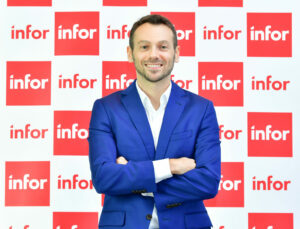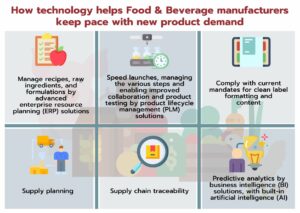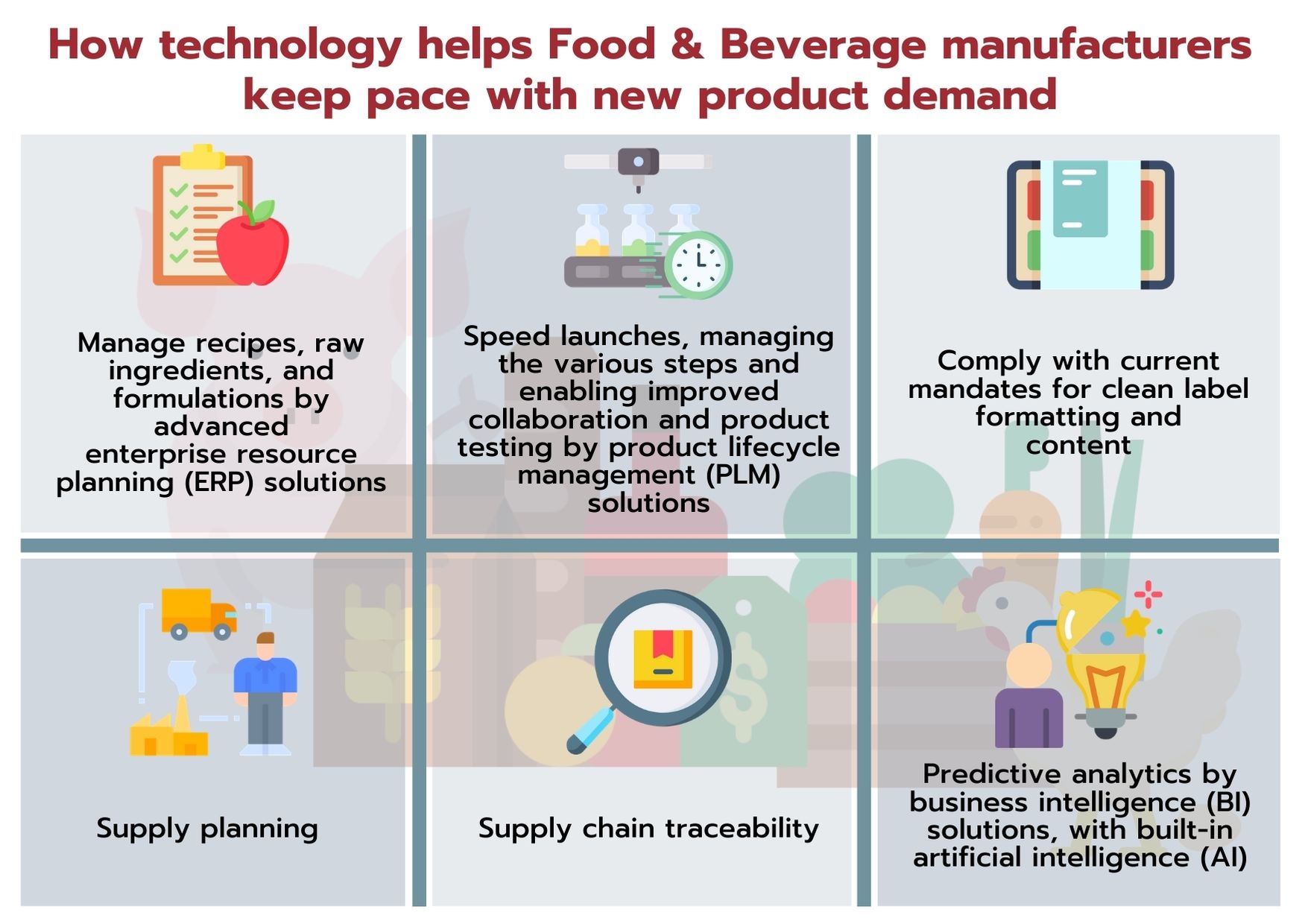
Article by Fabio Tiviti, Vice President ASEAN, Infor
Many consumers are passionate about the quality of their food, the health implications, and the environmental footprint made by food manufacturers. To meet their shifting expectations, food and beverage manufacturers must speed product introductions and develop new offerings that reflect the changing views on what is fresh, healthy, and mindful—and technology can help. It’s not just taste, freshness, and convenience that drive food purchases today. Conscientious consumers also focus on health, wellness, and social issues as they shop for family meals. They take nutrition labels, visibility into suppliers, humane treatment of animals, and environmental sustainability into consideration when shopping for food. While these expectations put added pressure on food and beverage manufacturers, companies that turn to technology to help, should seize the opportunity. Meeting the demands of today’s socially aware consumers can be a valuable differentiator.
The growing demands
It starts with the farm. Consumers today want to learn more about the origins of their food and its journey from farm to fork. The International Food Information Council (IFIC) Foundation states in a recent paper about food trends for 2019, “Americans have a growing appetite for more information about their food, and technology is enabling eaters like never before… it’s also driving transparency across the food supply chain.”
Pharma-nutritional. It is not strictly millennials looking for health-related options. People of all ages are turning to vitamins, minerals, and other ingredients that are potentially beneficial for bone, joint, immune system, digestive, and brain health. Mintel’s research shows 20% of US consumers aged 65-plus currently use a supplement for joint health. As consumers seek food and drink products that reduce
inflammation, more products will feature ginger, turmeric, green tea extract, and medicinal mushrooms.
Crossover health and beauty. Food and beverage manufacturers can benefit from research done by the beauty industry, which once revealed certain berries and spices that have been found to have anti-aging benefits. Also gaining attention are omega-3 fatty acids, biotin, aloe vera, and coenzyme Q10, an antioxidant that benefits heart health. In the past, companies were reluctant to make these investments as they were limited on what health benefit claims they could make. Today’s well-informed consumer requires less background education and explanation of claims on a package. The challenge is more in determining what ingredients are appropriate in what product.
Sustainability. The International Food Information Council (IFIC) Foundationsays, “There is a movement towards circularity as new approaches to sustainability span the entire life of a product, from ingredient sourcing to package design, disposal, or reuse. The 360-degree approach reflects the principles of a circular economy, where resources are kept in use for as long as possible, extracting the maximum value while in use and then recovering materials at the end of use.”
Rethinking plastic. Plastics have come under fire globally, pushing demand for new packaging innovations. Bio-based packaging materials will likely be key components to the next generation of responsible packaging. Additionally, initiatives such as“Loop” are attempting to bring back the idea of returnable and re-usable packaging.
Less waste. In 2018, awareness around “ugly produce” grew. Fruit and vegetables, that fall outside of the specifications retailers typically insist upon, got a second chance. Tesco became the exclusive retailer for a range of fruit juices, Waste NOT, which are made from produce designated as “ugly”.
Soil conservation. Healthy, nutrient-rich soil provides the foundation for healthy food. Companies should play a role in helping to replenish the soil. For example, US baby food brand, Gerber’s is hoping that its holistic approach and organic agriculture, featured in its “Clean Field Farming” line, will pay-off and increase biodiversity as well as enhance ecosystems. Additionally, Annie’s Homegrown is another brand helping to raise awareness in this area.
Reducing sugar. Many people are responding to dietary guidance that recommends eating less added sugar, with 77% saying they are taking steps to limit or avoid sugars in their diet, and 59% viewing sugars as negative, according to the 2015–2020 Dietary Guidelines for Americans report. New plant-based and dairy sweeteners are gaining attention and providing new opportunities for updating classic product offerings.
Vegetarians. Plant-based eating continues to gain adoption, with sales of “vegetarian alternatives” growing by 20% since 2017. Only 5% of Americans identify as vegetarians and 3% as vegans, according to a Gallup poll, but others are adding vegetables and reducing protein consumption for general health benefits.

How technology helps manufacturers keep pace with new product demand
In order to remain relevant, food and beverage manufacturers must continually stay tuned into trends and update product offerings. Fortunately, technology can help in several ways:
Product innovation. Introducing new products quickly is a necessity. New product lines can represent healthier choices and include minerals and nutrients associated with wellness. Reducing sugars, artificial colors, and preservatives will also appeal to many modern consumers. Advanced enterprise resource planning (ERP) solutions, purpose-built for the food and beverage industry, will help manage recipes, raw ingredients, and formulations—ensuring the quality is maintained. Product lifecycle management solutions (PLM) also help speed launches, managing the various steps and enabling improved project management, collaboration and product testing.
Clean labels. Transparency and visibility into how food is produced is increasingly important. Labels are the key tactic for conveying messages. “With today’s instant access to information, if a consumer can’t understand or find out where and how a product is made and what’s in it, they’ll be more inclined to leave it behind,” says RSM, which serves as a consultant to the industry. Food and beverage manufacturers can turn to technology to help comply with current mandates for clean label formatting and content. PLM solutions help streamline the process, making it easier to stay within compliance.
Supply planning. As new ingredients come to market and the demand for them starts to expand, the challenge may quickly become a supply shortage. Companies must work closely with their suppliers and leverage supply chain planning tools so retailers can meet the demand.
Supply chain traceability. This is one of the top five food trends in 2019, according to the International Food Information Council (IFIC) Foundation, and it is expected to continue and will cause demand for technology solutions which provide clear product information. They note that as technologies become cheaper and therefore more accessible, more food manufacturers will be able to utilize them to manage supply chain activities. Modern supply chain management solutions are essential for full visibility and tracking suppliers.
Predictive analytics. Modern business intelligence (BI) solutions, with built-in artificial intelligence (AI), will help companies project trends and anticipate market demands. This insight into the future helps procure raw ingredients and plan use of resources, like machinery, packaging, and personnel.
Final takeaway
The world of food and beverage manufacturing is ever-changing—with taste becoming just one of many factors influencing a consumer’s decisions. Today, health, wellness, and social issues like environmental sustainability are just as important. Manufacturers can see this as a challenge or as an opportunity to align with customers. With modern technology in place, companies can seize the chance to speed introductions and offer new product lineups which will appeal to consumers. This can be the ticket to future growth.

บทความโดย นายฟาบิโอ ทิวิติ รองประธานบริษัท อินฟอร์ อาเชียน
ผู้บริโภคจำนวนมากเอาจริงเอาจังกับเรื่องคุณภาพอาหารที่จะบริโภค ผลกระทบต่าง ๆ ที่เกี่ยวข้องถึงสุขภาพ และสิ่งแวดล้อมที่เกิดจากผู้ผลิตอาหาร เพื่อตอบสนองต่อความคาดหวังของผู้บริโภคที่เปลี่ยนแปลงไป ผู้ผลิตอาหารและเครื่องดื่มจึงจำต้องเร่งให้มีการแนะนำ และพัฒนาผลิตภัณฑ์ใหม่ ๆ ที่สะท้อนให้เห็นถึงมุมมองที่เปลี่ยนไปในเรื่องของความสดใหม่ ผลดีต่อสุขภาพ และความใส่ใจในกระบวนการผลิต เทคโนโลยีสามารถเข้ามาช่วยทำให้สิ่งเหล่านี้เกิดขึ้นได้ ปัจจัยที่ผลักดันให้เกิดการจับจ่ายใช้สอยเรื่องอาหารการกินในทุกวันนี้ ไม่ใช่เพียงแค่เรื่องรสชาติ ความสดใหม่ และความสะดวกสบายเท่านั้น เมื่อต้องเลือกซื้ออาหารให้กับครอบครัว ผู้บริโภคจะใช้วิจารณญาณให้ความสำคัญในประเด็นสุขภาพ ประโยชน์ต่อร่างกายและเหตุปัจจัยทางสังคมอีกด้วย โดยพวกเขาจะอ่านฉลากโภชนาการ หาข้อมูลตัวตนหรือความเป็นมาของซัพพลายเออร์ การคุ้มครองสวัสดิภาพสัตว์ และการรักษาความยั่งยืนของสภาพแวดล้อม มาตรฐานต่าง ๆ ที่ผู้บริโภคคาดหวังไว้เหล่านี้ ล้วนเพิ่มแรงกดดันให้กับผู้ผลิตอาหารและเครื่องดื่ม ทว่าบริษัททั้งหลายที่มีการนำเทคโนโลยีเข้ามาช่วยก็ควรจะไขว่คว้าโอกาสนี้ไว้ เพราะการตอบสนองต่อความต้องการของผู้บริโภคในปัจจุบันที่มีความตระหนักรู้และรับผิดชอบต่อสังคม จะช่วยให้บริษัทสร้างความแตกต่างที่คุ้มค่าได้
ความต้องการของผู้บริโภคที่เพิ่มขึ้นในด้านต่าง ๆ
เริ่มต้นจากแหล่งเพาะปลูก – ปัจจุบันผู้บริโภคต้องการทราบข้อมูลเกี่ยวกับแหล่งที่มาของอาหารและเส้นทางที่เริ่มต้น จากแหล่งเพาะปลูกมาจนถึงจานอาหารมากขึ้น จากรายงาน “แนวโน้มทิศทางอุตสาหกรรมอาหารของตลาดประเทศอาเซียนและจีน” ระบุถึงการที่ประชากรในเขตเมืองจะยอมจ่ายเพิ่มเพื่อคุณภาพที่ดีกว่า รวมถึงการเพิ่มขึ้นของผู้สูงอายุชาวไทยและชาวสิงคโปร์ ทำให้ประชากรใส่ใจเรื่องสุขภาพและข้อมูลอาหารมากขึ้น มูลนิธิ The International Food Information Council (IFIC) ระบุในรายงานล่าสุดเกี่ยวกับแนวโน้มด้านอาหาร ปี 2562 ว่า “ชาวอเมริกันมีความต้องการเสพข้อมูลข่าวสารเกี่ยวกับอาหารที่พวกเขาบริโภคเพิ่มมากขึ้นตลอดเวลา และเทคโนโลยีก็ช่วยผู้ที่ชมชอบการรับประทานอาหารได้มากอย่างไม่เคยเป็นมาก่อน…นอกจากนี้ยังได้ช่วยผลักดันให้เกิดความโปร่งใสด้านซัพพลายเชนอาหารอีกด้วย”
โภชนเภสัช – ไม่ใช่คนรุ่นมิลเลนเนียลเท่านั้นที่มองหาทางเลือกที่เกี่ยวกับสุขภาพอย่างจริงจัง คนทุกวัยต่างหันมาใช้วิตามิน เกลือแร่ และส่วนประกอบอื่น ๆ ที่อาจจะเป็นประโยชน์ต่อกระดูก ข้อต่อ ระบบภูมิคุ้มกัน การย่อยอาหาร และสุขภาพสมองของตน จากงานวิจัยของ Mintel ระบุว่า 20% ของผู้บริโภคชาวอเมริกันที่มีอายุ 65 ปีขึ้นไป ใช้อาหารเสริมเพื่อสุขภาพเกี่ยวกับข้อต่อ และเนื่องจากผู้บริโภคต่างเสาะหาผลิตภัณฑ์อาหารและเครื่องดื่มต่าง ๆ ที่ช่วยลดอาการอักเสบได้ ดังนั้นจึงเกิดผลิตภัณฑ์มากมายหลายชนิดที่มีส่วนผสมของขิง ขมิ้น สารสกัดชาเขียว และเห็ดต่าง ๆ ที่สามารถใช้รักษาโรคได้
เมื่อสุขภาพและความงามไปด้วยกัน – ผู้ผลิตอาหารและเครื่องดื่มสามารถใช้ประโยชน์จากงานวิจัยที่จัดทำโดยอุตสาหกรรมความงามซึ่งครั้งหนึ่งเคยเปิดเผยถึงผลเบอรี่และเครื่องเทศบางชนิดที่ให้ประโยชน์ในการชะลอวัยได้ นอกจากนี้สิ่งที่ได้รับความสนใจอื่น ๆ ได้แก่กรดไขมันโอเมก้า-3 ไบโอติน อโลเวร่า และโคเอนไซม์คิวเท็น ซึ่งเป็นสารอนุมูลอิสระที่มีประโยชน์ต่อหัวใจ ที่ผ่านมาบริษัทต่าง ๆ ไม่ค่อยเต็มใจลงทุนทางด้านนี้มากเท่าใดนัก เนื่องจากข้อจำกัดในการอ้างอิงถึงคุณประโยชน์ต่าง ๆ ด้านสุขภาพ ปัจจุบันผู้บริโภคที่มีข้อมูลพร้อม ต้องการข้อมูลพื้นฐานและคำอธิบายต่าง ๆ บนบรรจุภัณฑ์น้อยลง ดังนั้นความท้าทายของผู้ผลิตจึงอยู่ที่การตัดสินใจเลือกส่วนผสมให้เหมาะกับชนิดของผลิตภัณฑ์มากกว่า
ความยั่งยืน – มูลนิธิ IFIC ระบุว่า “ความเคลื่อนไหวด้านความยั่งยืนนั้นเกิดขึ้นเป็นวัฎจักร เนื่องจากมีวิธีใหม่ ๆ ในการพัฒนาอย่างยั่งยืนที่ครอบคลุมตลอดอายุการใช้งานของผลิตภัณฑ์ นับตั้งแต่เรื่องแหล่งวัตถุดิบไปจนถึงการออกแบบบรรจุภัณฑ์ การกำจัดขยะ หรือการนำกลับมาใช้ใหม่อีกครั้ง วิธีการแบบ 360 องศานี้สะท้อนให้เห็นถึงหลักการของเศรษฐกิจหมุนเวียนที่มีการรักษาทรัพยากรต่าง ๆ ไว้ใช้งานให้นานที่สุดเท่าที่จะเป็นไปได้ เป็นการนำเอาคุณค่าของทรัพยากรมาใช้ให้เกิดประโยชน์สูงสุด และนำวัสดุกลับไปใช้งานใหม่อีกครั้งเมื่อหมดอายุการใช้งาน”
การปรับเปลี่ยนพฤติกรรมในการใช้พลาสติก – วัสดุอุปกรณ์ต่าง ๆ ที่ทำจากพลาสติกได้กลายเป็นหัวข้อร้อนแรงระดับโลก ซึ่งผลักดันให้เกิดความต้องการด้านนวัตกรรมบรรจุภัณฑ์ใหม่ ๆ วัสดุบรรจุภัณฑ์ชีวฐานจะกลายเป็นส่วนประกอบสำคัญในการผลิตบรรจุภัณฑ์รุ่นใหม่ ๆ ที่มีความรับผิดชอบต่อสังคม ความคิดริเริ่มต่าง ๆ เช่น โครงการ “Loop” หรือ “Upcycling SE Project” ก็กำลังพยายามที่จะนำแนวความคิดเรื่องบรรจุภัณฑ์ที่สามารถส่งคืนและนำกลับมาใช้ใหม่ได้ กลับมาอีกครั้งหนึ่ง
ขยะน้อยลง – ในปี 2561 ได้เกิดความตระหนักรู้เกี่ยวกับ “ผลผลิตที่ไม่น่ากิน: ugly produce” ขึ้น พืชผักผลไม้ที่มีคุณสมบัติไม่ตรงตามข้อกำหนดที่ผู้ค้าปลีกระบุได้รับโอกาสอีกครั้งหนึ่ง โดยทางเทสโก้ได้กลายเป็นผู้ค้าปลีกพิเศษแต่เพียงผู้เดียวที่จำหน่ายน้ำผลไม้ประเภท “Waste NOT” หลากหลายชนิดซึ่งล้วนแล้วแต่ทำมาจากผลผลิตที่ถูกระบุว่า “ไม่น่ากิน” ทั้งสิ้น
การอนุรักษ์ดิน – ดินดีอุดมสมบูรณ์ด้วยสารอาหารเป็นรากฐานของอาหารเพื่อสุขภาพ บริษัทต่าง ๆ ควรเข้ามามีบทบาทในการทำให้ดินอยู่ในสภาพที่สมบูรณ์ เช่น แบรนด์สินค้าอาหารสำหรับทารกของประเทศอเมริกา “Gerber” ที่กำลังหวังว่าแนวทางแบบองค์รวมและเกษตรอินทรีย์ที่อยู่ในสายผลิตภัณฑ์ “Clean Field Farming” ของบริษัทฯ จะประสบความสำเร็จ และช่วยเพิ่มความหลากหลายทางชีวภาพ รวมทั้งช่วยปรับปรุงระบบนิเวศให้ดีขึ้นด้วย นอกจากนี้ Annie’s Homegrown ก็ยังเป็นอีกแบรนด์หนึ่งที่ช่วยสร้างความรับรู้ให้แก่ผู้บริโภคในเรื่องนี้
การลดน้ำตาล – จากรายงานคำแนะนำในการบริโภคอาหารสำหรับชาวอเมริกัน ปี 2558-2563 (Dietary Guidelines for Americans 2015-2020) พบว่าคนจำนวนมากเชื่อคำแนะนำในการให้รับประทานน้ำตาลน้อยลง โดย 77% กล่าวว่าพวกเขากำลังค่อย ๆ จำกัดหรือหลีกเลี่ยงน้ำตาลในอาหาร และอีก 59% เห็นว่าน้ำตาลเป็นของไม่ดี สารให้ความหวานจากพืชแบบใหม่หรือที่ได้จากผลิตภัณฑ์นม กำลังได้รับความสนใจเพิ่มขึ้น และเพิ่มโอกาสทางธุรกิจใหม่ ๆ ให้กับผู้ผลิตในการปรับปรุงผลิตภัณฑ์แบบคลาสสิกให้ดีขึ้น
มังสวิรัติ – การรับประทานอาหารที่มาจากพืชเป็นหลักยังคงได้รับการยอมรับเพิ่มมากขึ้น โดยยอดขายอาหาร “ทางเลือกมังสวิรัติ” เพิ่มขึ้นถึง 20% ตั้งแต่ปี 2560 จากโพลล์ของ Gallup พบว่ามีชาวอเมริกันเพียง 5% เท่านั้นที่ระบุว่าเป็นมังสวิรัติ และอีก 3% เป็นวีแกน แต่สำหรับคนอื่น ๆ มีการเพิ่มผักชนิดต่าง ๆ และลดการบริโภคโปรตีนเพื่อประโยชน์ด้านสุขภาพทั่วไป สำหรับประเทศไทยพบว่ามีชาวไทยเพียง 3.3% ที่เป็นมังสวิรัติ
แล้วเทคโนโลยีช่วยให้ผู้ผลิตก้าวทันความต้องการผลิตภัณฑ์ใหม่อย่างไร
เพื่อให้ก้าวทันต่อเหตุการณ์ ผู้ผลิตอาหารและเครื่องดื่มจะต้องทันเทรนด์ต่าง ๆ และอัปเดตการนำเสนอ ผลิตภัณฑ์อย่างต่อเนื่อง ซึ่งเทคโนโลยีสามารถช่วยได้หลากหลายวิธีดังนี้

นวัตกรรมด้านผลิตภัณฑ์ – การเปิดตัวผลิตภัณฑ์ใหม่ ๆ อย่างรวดเร็วถือเป็นเรื่องที่จำเป็น กลุ่มผลิตภัณฑ์ใหม่ ๆ แสดงถึงทางเลือกที่ดีต่อสุขภาพได้ อีกทั้งยังมีการเพิ่มแร่ธาตุและสารอาหารที่เกี่ยวข้องกับความสมดุลของสุขภาพเข้าไปในผลิตภัณฑ์ด้วย การลดน้ำตาล สีสังเคราะห์ และวัตถุกันเสียในผลิตภัณฑ์สามารถดึงดูดความสนใจจากผู้บริโภคยุคใหม่จำนวนมากได้เช่นกัน โซลูชั่นด้านการวางแผนทรัพยากรองค์กรที่ทันสมัย (enterprise resource planning – ERP) สำหรับอุตสาหกรรมอาหารและเครื่องดื่มโดยเฉพาะจะช่วยจัดการเรื่องสูตรอาหาร วัตถุดิบ และสูตรในการผลิตต่าง ๆ ทำให้มั่นใจว่าสามารถรักษาคุณภาพให้ตรงตามมาตรฐานที่กำหนด ส่วนโซลูชั่นในการจัดการวงจรการผลิต (Product lifecycle management – PLM) ยังช่วยเร่งความเร็วในการเปิดตัวผลิตภัณฑ์ จัดการขั้นตอนต่าง ๆ พร้อมปรับปรุงการบริหารจัดการโครงการ การทำงานร่วมกัน และการทดสอบผลิตภัณฑ์ให้ดีขึ้น
ฉลากชัดเจน (Clean labels) – ความโปร่งใสและความชัดเจนในกระบวนการผลิตอาหารกำลังทวีความ สำคัญมากยิ่งขึ้น ฉลากสินค้าเป็นกลยุทธ์สำคัญในการถ่ายทอดข้อความต่าง ๆ (ที่ต้องการสื่อถึงผู้บริโภค) บริษัทที่ปรึกษาด้านอุตสาหกรรม RSM กล่าวว่า “ปัจจุบันผู้บริโภคสามารถเข้าถึงข้อมูลได้ทันที หากเขาไม่เข้าใจหรือไม่สามารถหาข้อมูลได้ว่าผลิตภัณฑ์นั้น ๆ ผลิตขึ้นมาอย่างไรและมีอะไรอยู่ในนั้นบ้าง ก็มีแนวโน้มว่าพวกเขาจะไม่สนใจผลิตภัณฑ์นั้น ๆ ผู้ผลิตอาหารและเครื่องดื่มสามารถหันมาใช้เทคโนโลยีเพื่อช่วยจัดรูปแบบและเนื้อหาของป้ายกำกับแบบ clean label ให้เป็นไปตามข้อบังคับปัจจุบัน โซลูชั่น PLM ช่วยปรับปรุงกระบวนการทำงานให้ง่าย และเป็นไปอย่างถูกต้องครบถ้วนตามข้อกำหนด
การวางแผนด้านซัพพลาย – เมื่อผลิตภัณฑ์ต่าง ๆ ออกสู่ตลาด และเริ่มเป็นที่ต้องการมากขึ้น ความท้าทายที่อาจเกิดขึ้นอย่างรวดเร็วคือสินค้ามีไม่เพียงพอต่อการจำหน่าย บริษัทต่าง ๆ ต้องทำงานอย่างใกล้ชิดกับซัพพลายเออร์ และใช้ประโยชน์จากเครื่องมือการวางแผนด้านซัพพลายเชน เพื่อให้ผู้ค้าปลีกสามารถตอบสนองความต้องการของผู้บริโภคได้
การสามารถตรวจสอบย้อนกลับระบบซัพพลายเชน – มูลนิธิ International Food Information Council (IFIC) ระบุว่าเรื่องนี้ติดหนึ่งในห้าอันดับแรกของแนวโน้มด้านอาหารในปี 2562 และคาดว่าจะยังเป็นเรื่องที่อยู่ในความสนใจของผู้บริโภคต่อไปอีก และจะทำให้เกิดความต้องการโซลูชั่นที่สามารถให้ข้อมูลผลิตภัณฑ์ที่ชัดเจน ผู้ผลิตอาหารจำนวนมากขึ้นทราบดีว่าเทคโนโลยีต่าง ๆ มีราคาถูกลง และสามารถเข้าถึงได้มากขึ้น ดังนั้นพวกเขาจึงสามารถใช้ประโยชน์จากเทคโนโลยีเหล่านั้นในการจัดการกิจกรรมต่าง ๆ ที่เกี่ยวข้องกับซัพพลายเชนได้ โซลูชั่นการจัดการซัพพลายเชนสมัยใหม่ถือเป็นสิ่งสำคัญต่อการมองภาพรวมและการติดตามตรวจสอบซัพพลายเออร์
การวิเคราะห์เชิงคาดการณ์ – โซลูชั่นธุรกิจอัจฉริยะ (business intelligence – BI) ที่ทันสมัยที่มีปัญญาประดิษฐ์ (AI) ติดตั้งมาด้วย จะช่วยให้บริษัทต่าง ๆ คาดการณ์แนวโน้ม และความต้องการของตลาด ข้อมูลเชิงลึกที่วิเคราะห์ถึงอนาคตจะช่วยในการเตรียมวัตถุดิบ และวางแผนการใช้ทรัพยากรต่าง ๆ ได้ เช่น ด้านเครื่องจักร บรรจุภัณฑ์ และบุคลากร
สรุปประเด็นสำคัญ
โลกของการผลิตอาหารและเครื่องดื่มมีการเปลี่ยนแปลงตลอดเวลา เรื่องรสชาติเป็นเพียงหนึ่งในปัจจัย หลากหลายประการที่มีอิทธิพลต่อการตัดสินใจของผู้บริโภค ทุกวันนี้ประเด็นด้านสุขภาพ ความสมดุลของร่างกาย และเหตุปัจจัยทางสังคม เช่น ความยั่งยืนของสิ่งแวดล้อม ต่างก็มีความสำคัญเท่าเทียมกัน ขึ้นอยู่กับว่าผู้ผลิตจะเห็นเรื่องนี้เป็นความท้าทายหรือเป็นโอกาสในการปรับให้เข้ากับลูกค้า และด้วยการมีเทคโนโลยีทันสมัยพร้อมใช้งานจะช่วยให้บริษัทต่าง ๆ สามารถคว้าโอกาสในการเร่งเปิดตัว และนำเสนอกลุ่มผลิตภัณฑ์ใหม่ ๆ เพื่อดึงดูดใจผู้บริโภค ซึ่งจะเป็นตัวช่วยนำพาบริษัทก้าวไปสู่ความเจริญเติบโตในอนาคต


